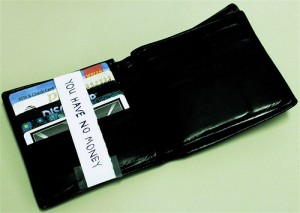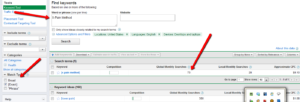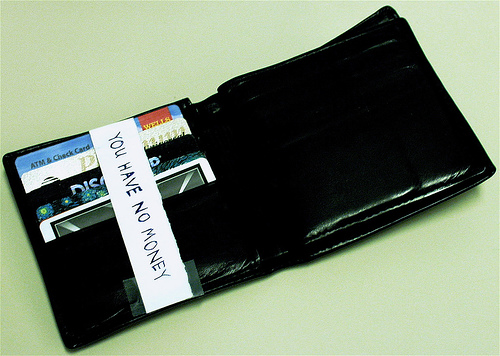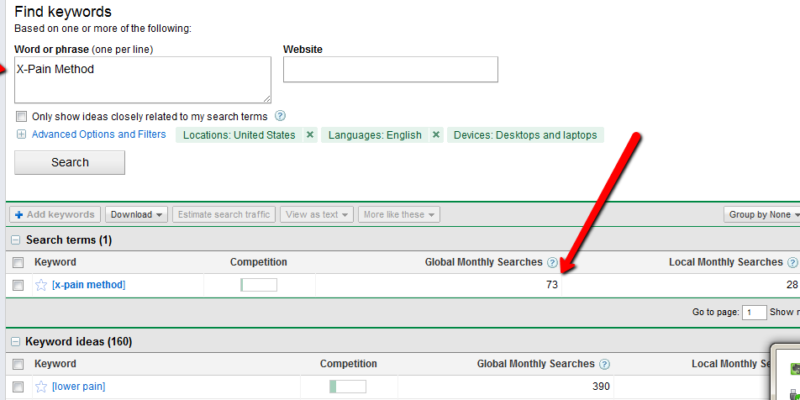- Uop past midnight. 3am feeding. 5am hurts. Back to bed? #
- Stayed up this morning and watched Terminator:Salvation. AWAKs make for bad plot advancement. #
- Last night, Inglorious Basterds was not what I was expecting. #
- @jeffrosecfp It's a fun time, huh. These few months are payment for the fun months coming, when babies become interactive. 🙂 in reply to jeffrosecfp #
- RT @BSimple: RT @bugeyedguide: When we cling to past experiences we keep giving them energy…and we do not have much energy to spare #
- RT @LivingFrugal: Jan 18, Pizza Soup (GOOOOOD Stuff) http://bit.ly/5rOTuc #budget #money #
- Free Turbotax for low income or active-duty military. http://su.pr/29y30d #
- To most ppl,you're just somebody [from casting] to play the bit part of "Other Office Worker" in the movie of their life http://su.pr/1DYMQZ #
- RT @MoneyCrashers: Money Crashers 2010 New Year Giveaway Bash – $8,300 in Cash and Amazing Prizes http://bt.io/DQHw #
- RT: @flexo: RT @wisebread: Tylenol, Motrin, Rolaids, and Benadryl RECALLED! Check your cabinets: http://bit.ly/4BVJfJ #
- New goal for Feb. 100 pushups in 1 set. Anyone care to join me? #
- RT @BSimple: Your future is created by what you do today, not tomorrow"— Robert Kiyosaki So take action now. #
- RT @hughdeburgh: "Everything you live through helps to make you the person you are now." ~ Sophia Loren #
- Chances of finding winter boots at a thrift store in January? Why do they wear our at the worst time? #
- @LenPenzo Anyone who make something completely idiot proof underestimates the ingenuity of complete idiots. in reply to LenPenzo #
- RT @zappos: "Lots of people want to ride w/ you in the limo, but what you want is someone who will take the bus w/ you…" -Oprah Winfrey #
- RT @chrisguillebeau: "The cobra will bite you whether you call it cobra or Mr. Cobra" -Indian Proverb (via @boxofcrayons) #
- RT @SuburbanDollar: I keep track of all my blogging income and expenses using http://outright.com it is free&helps with taxes #savvyblogging #
- Reading: Your Most Frequently Asked Running Questions – Answered http://bit.ly/8panmw via @zen_habits #
My Financial Plan – How I Improve on Ramsey
In April, my wife and I decided that debt was done. We have hopefully closed that chapter in our lives. I borrowed, then purchased, The Total Money Makeover by Dave Ramsey.  budget” width=”300″ height=”213″ />We are almost following his baby steps. Our credit has always been spectacular, but we used it a lot. Our financial plan is Dave Ramsey’s The Total Money Makeover, with some adjustments.
budget” width=”300″ height=”213″ />We are almost following his baby steps. Our credit has always been spectacular, but we used it a lot. Our financial plan is Dave Ramsey’s The Total Money Makeover, with some adjustments.
Step 1. Budget:
The budget was painful, and for the first couple of months, impossible. We had no idea what bills were coming due. There were quarterly payments for the garbage bill and annual payments for the auto club. It was all a surprise. Surprises are setbacks in a budget.
When something came up, we’d start budgeting for it, but stuff kept coming up. We’re not on top of all of it, yet, but we are so much closer. We’ve got a virtual envelope system for groceries, auto maintenance, baby needs(we have two in diapers) and some discretionary money. We set aside money for everything that isn’t a monthly expense, and have a line item for everything that is. My wife is eligible for overtime and monthly bonuses. That money does not get budgeted. It’s all extra and goes straight on to debt, or to play catch-up with the bills we had previously missed. I figure it will take a full year to get all of the non-monthly expenses in the budget and caught up.
Step 2. The initial emergency fund:
Ramsey recommends $1000, adjusted for your situation. I decided $1000 wasn’t enough. That isn’t even a month’s worth of expenses. We settled on $1800, plus $25/month. It’s still not enough, but it’s better. Hopefully, we’ll be able to ignore it long enough that the $25/month accrues to something worthwhile.
Step 3. The Debt Snowball:
This is the controversial bad math. Pay off the lowest balance accounts first, then take those payments and apply them to the higher balance accounts. Emotionally, it’s been wonderful. We paid off the first credit card in a couple of weeks, followed 6 weeks later by my student loan. Since April, we’ve dropped nearly $10,000 and we haven’t made huge cuts to our standard of living. At least monthly, we re-examine our expenses to see what else can be cut.
Step 4. Three to six months of expenses in savings:
We aren’t on this step yet. In step 2, we are consistently depositing more, making us more secure every month.
Step 5. Invest 15% of household income into Roth IRAs and pre-tax retirement:
I have not stopped my auto-deposited contribution. It’s stupid to pass up an employer match. My wife’s company does not match, so she is currently not contributing.
Step 6. College funding for children:
We have started a $10 College fund.
Step 7. Pay off home early:
I don’t see the point in handling this one separately. Our mortgage is debt, and when the other debts are paid, we will be less than a year from owning our house, free and clear. This is rolled in with step three. All debt is going away, immediately.
Step 8. Build wealth and give!
We have cut off most of our charitable giving. Every other year, it has been a significant percent of our income, and in a few more years, will be so again. The only exception to this is children knocking on the door for fundraisers. I have no problems with saying no to a parent fundraising for their kid, but when the kids is doing the work, door-to-door, especially in the winter, I buy something. My son’s school, on the other hand, gets fundraisers ignored. When they come home, I send a check to the school, ignoring the program. I bypass the overhead and make a direct donation.
5 Ways to Save Money by Going Green
This is a guest post by MoneySuperMarket.
Making changes in your daily life that minimize your impact on the environment is the right way to go green. While most people are happy just to know the environment is being protected, there are other benefits to going green. Pick a few of these five lifestyle changes and enjoy having a little extra cash in your pocket as well.
Eat More Meals At Home
Dining out is a fun family experience, but it takes its toll on your wallet and your neighborhood. Restaurants create millions of tons of trash each year. This tip is to the people who already avoid fast food for health reasons, but cooking with your friends and family is a great way to get closer.
Pick Up A Creative Hobby
Some hobbies require a lot more equipment or materials, therefore creating more waste and using more energy. Creative extracurricular activities use inexpensive or recycled goods instead, requiring fewer trips to the sports goods store. Woodcarving can be practiced with scraps from cabinetmakers, while yarn for knitting can come from old sweaters that are no longer worn.
Cool Off The Hot Water Heater
Each water heater features a small screw or dial that allows you to set the perfect temperature. Millions of people have their heaters set higher than necessary, wasting a lot of electricity each year. You can safely turn the heat down to about 125 degrees Fahrenheit, which could net you some hefty annual savings if it is at 140 or 150 degrees right now. Most people never use water for washing or showering that is higher than 130 when mixed in the tap.
Carpool With Co-workers
Driving back and forth to work puts a lot of wear and tear on your vehicle. Rising gas prices has made it even harder to afford a long daily commute by car. Sharing the responsibility among a group of co-workers or fellow parents at your child’s school can help to spread out the costs and the impact on the environment.
Try Your Hand At Gardening
You don’t have to have a green thumb to grow your favorite herbs in a windowsill pot. Start out easy and try a potted dwarf lime tree or a terracotta planter full of strawberries on the patio. The vegetables you harvest don’t have to contain pesticides. Compare your gardening costs against prices for high-end organic produce at the store. You could save thousands of dollars each year and reduce the damaging effects of large-scale agriculture.
Make Extra Money Part 4: Keyword Research
In this installment of the Make Extra Money series, I’m going to show you how I do keyword research.
Properly done–unless you get lucky–this is the single most time-consuming part of making a niche site. If you aren’t targeting search terms that people use, you are wasting your time. If you are targeting terms that everybody else is targeting, it will take forever to get to the top of the search results.
Spend the extra time now to do proper keyword research. It will save you a ton of time and hassle later. This is time well-spent.
If you remember from the last installment, when we researched products to promote, we narrowed our choices down to a few products.
What I’ve done is create a spreadsheet to score the products. You can see the spreadsheet here. I’ll explain the columns as we populate them.
The first column contains the name of the product. Easy. We’ve got 10 products. I’m going to walk through scoring 1 product, then, through the magic of the internet, I’ll populate the rest, and you’ll get to see the results instantly. Wow.
The second column is the global search volume for the exact search term. I base my product niche sites primarily on the demand for a given product. Everything else is a secondary consideration.
To find the demand for a product, go to the Google Adwords Keyword Tool. In the “word or phrase” box, enter your product name, exactly. In this case, it’s “X-Pain Method”. When the search results come up, change the match type to “Exact”. You should have something like this:

Enter the global search volume in column 2. In this case, it’s 73. Keep this window open, because we’ll be coming back to it.
Column 3 is the search competition. Go to google and enter your product name, in quotes. In this case, “X-Pain Method”. Put the total number of search results in column 3: 223000.

Column 4 is the search competition, but only what appears in a page’s title. Your search query is intitle:”X-Pain Method”, which yields 4400 results.
The next column is for the average PageRank of the first page of search results. For this, I use Traffic Travis. I use the 4th edition, which is paid software, but you can get the free version of version 3, instead. I’ll use version 3 for this example. Open the software and click on “SEO Analysis” on the bottom left of the screen. Put your search term (“X-Pain Method”) in the “phrase to analyze” and set the “Analyze Top” to 10, then hit “Analyze”. When it’s done running, just add up all of the PRs and divide by 10. Ignore Travis’s difficulty rating.
Now, for the rest of the columns, we’re going to look at the keyword tool again. We’re going to pick 3 alternate search terms. Here are the criteria:
- At least 1000 global monthly searches. We want terms that people are searching for.
- Competition bar at medium or less. This bar is just a rough guess on competition, so it’s really an arbitrary exclusion factor, but it helps narrow down the choices.
- A “buying” keyword is preferred, but not necessary. This is a term that indicates people are looking to spend money. “Back pain doctor” is a buying keyword, but it’s not an indicator that someone wants to buy a product, so we’ll skip it. A buying keyword isn’t absolutely necessary, because these will also be the terms we’ll use to generate content later.
- It has to be related to our product.
Once we pick the keywords, we’ll throw them into google to get the competition, just like we did to populate column 2.
“Exercises for back pain” has medium competition and 1900 monthly searches. It also has an estimated cost-per-click of $3.02, which means people are paying for this.
“Lower back pain exercises” has 6600 searches and medium competition. It’s actually on the lower end of medium, so it looks really promising.
“Lower back” has 4400 searches and low competition, with a CPC of $6.24. This should be a good one. Scratch that. It has 40 million search results, but only 4400 searches. That’s a lot of competition for a small market.
Instead, I’m going to search for “cure back pain” in the keyword tool and see what I get. “Upper back pain” is better. Low competition, 18000 searches each month, and only 2000000 competing search results. Now, I’ll score it.
You really want at least 500 searches per month for the product name. More than 2500 is better. I’m going to assign 1 point per 500 monthly searches.
You also want a lower number of search results. Less than 10,000 is ideal. Less than 100,000 is still decent. More than 250,000, I’d walk. So, under 10,000 gets 5 points. Under 50,001 gets 4. Under 100,001 gets 3. Under 200,001 gets 2. Under 250,001 gets 1. Any higher gets 0.
The ideal intitle search will have less than 2000 results. More than 100,000 is too time-consuming to deal with. 0-2000: 5 points; 2001-10,000: 4 points; 10001-25000: 3 points; 25001-50000: 2 points; 50001 to 100000: 1 point.
The perfect product will have the first page of search result all with a PageRank of 0. That’s a 5 point product. I’ll knock off half a point for every point of average PR.
The related terms are more relaxed. They are what’s known as “Latent Semantic Indexing” (LSI) terms. We will be creating articles to match those search terms, mostly to make our niche site look as natural and real as possible. Any actual traffic those pages drive is just gravy. Points for the related searches start at 10 and get 1 point knocked off for each 3 million results. We’ll be treating the 3 terms as one for this score.
That gives us a perfect score of about 25. There’s no actual upper limit, since the score for the search volume has no upper limit. X-Pain Method scored 18.22.
Now, excuse me a moment while I score the rest.
I’m back. Did you miss me?
I’ve finished scoring each of the products and sorted the results by score. The clear winner is the back pain product, but the lack of searches bothers me. The wedding guide looks much nicer, especially if I target the phrase “wedding planning guide” during the SEO phase of the project. That change alone brings the score almost to first place.
Frankly, I’d take either 2nd or 3rd place over the back pain product. The bare numbers don’t support it, but my judgement tells me they are better products to promote.
There is one final step before deciding on the product. I have to buy it. I can’t review the product without seeing it and I can’t promote it without approving of it.
That’s the secret to ethical niche marketing, you know. Only promote good products that you’ve personally read, watched, or used.
Decision Making Made Easy
Have you ever had to make a difficult decision? Not necessarily a decision that’s difficult because it’s life-changing, but a decision that’s difficult because there are two phenomenally wonderful, yet mutually exclusive options?
For example:
- Should you put caramel or strawberry sauce on your ice cream?
- Should you go to Disney Land or Disney World?
- Should you subscribe to Live Real, Now by email or RSS?
- Should you take the job with the stellar benefits package or the higher salary?
These are all real decisions that you may be called on to make.
For most decisions, there are some alternatives that are easy to discard.
MadDog 20/20 isn’t a good alternative to caramel sauce on your ice cream. The local BDSM museum probably isn’t a great choice for a family vacation. Sending me hate mail is obviously worse than subscribing.
Then you’ve got some choices that are both okay, but one is clearly better. You’ve got free airfare and hotel. Do you go to Topeka, or Paris? Neither is horribly, but I think the choice is obvious. You’re going out to dinner. McDonald’s or…nevermind, this fits the first category.
After you’ve discarded the obvious bad choices and the okay-but-not-great choices, how can you decide between what’s left?
This is the point that starts to cause stress. What if you make the wrong choice? What if you regret it forever? What if you’re still not happy? Gridlock.
The reason your stuck is because it’s not apparent which is the better choice. All of your experiences and knowledge are telling you–on some level–that the options are identical in terms of your life, happiness, and goals. It truly does not matter which one you choose. You will probably be equally happy, either way.
Given that it doesn’t matter, you have two choices for making the final decision:
- Pick the one you want. The rational decision is a tie, so make it an emotional one. Does one job match your dreams, but with a bit more risk? Has one vacation destination been a goal since you were little? Do it!
- Flip a coin. If the decision doesn’t matter, leave it to fate. That way, if it doesn’t work out, you can always blame the quarter.
The one thing you don’t want to do is wait. Failing to decide is still a decision and one that is guaranteed to keep you from being satisfied with your choice. Don’t wait until you have all of the possible information, because that kind of perfect world doesn’t exist. Get to about 85% of fully informed and run with it. You’ll usually be happier making a decision–even the wrong one–than sitting back wondering “What if I had done that?”
How do you make hard decisions?
May 30 Day Project
Before I discuss May’s 30 day project, I’m going to talk about April’s.
Last month, my goal was to declutter my entire house. Every room, every closet, every drawer.
I missed the goal.
My wife has gotten behind this project wholeheartedly. She’s had friends over helping almost every weekend. She’s kept the kids occupied while I’ve been working on it. It’s been a team effort, which has been nice. One room at a time, we’ve tackled the entire house, except for a couple of spots.
Our son’s closet isn’t finished. He hasn’t had use of his closet since we moved him into the room he’s in. It’s been the filing center for a couple of business opportunities. Most of it has been cleared out, but not all. It will be finished in the next few days.
Our storage room isn’t done. It pains me to have a “storage room”, but I don’t think its purpose will be changing. Now, however, instead of unopened appliances and boxes of clothes, it’s almost down to just seasonal stuff and things we do need occasionally. We have the Christmas decorations, the pet crates, and a few other things that get used rarely, but do get used. This room used to have a 6-foot cabinet of computer parts, leftover from the days when building/supporting computers was my main side-hustle. That has been reduce to just one box, mostly power cords. The gaming pads and old hard drives are gone. All that’s left for this room is one shelf, and the remainder of another old side-hustle that has some emotional attachment for my wife.
The remaining trouble spots will be cleaned out by this weekend. We’re having a garage sale the following weekend, and it will all be there. We’ve been pricing as we’ve been sorting, so we’re almost ready.
Decluttering an entire house that’s been filled by the horrible habits of two accumulators means we literally have thousands of things we’ll be selling in two weeks. We split our garage with our roommmate. Our stall is full. We’ve got some stuff in the driveway. We’ve got a pile of boxes in the basement, ready to go. Our dining room is full.
Let me repeat that last point: Our dining room is full.
My project for May was supposed to have been having dinner at the table at least 3 nights per week. At the moment, I’m not entirely sure we still have a table. I certainly can’t see it and there is no way to use it for dinner. This project has to be moved.
So, what’s the plan for May? I’m going to tackle June’s project.
I will not use the computer while anyone else is awake, except for household necessities. Household necessities on the computer are almost nonexistent, since I’ve automated almost everything. I balance the checkbook on a monthly basis, and may have to pay a quarterly bill later this month. I’m going to take the time to be with my family, and do something that matters more than Google Reader. That means writing happens after everyone goes to bed, or at 5AM, which will be motivation to keep that wake-up time. Internet on the blackberry counts as computer use.
Family first.





